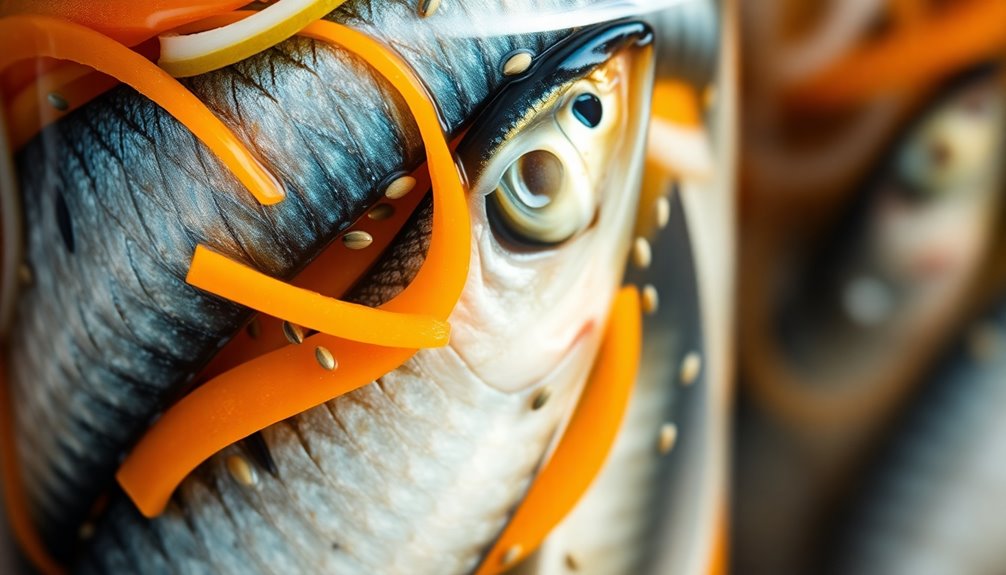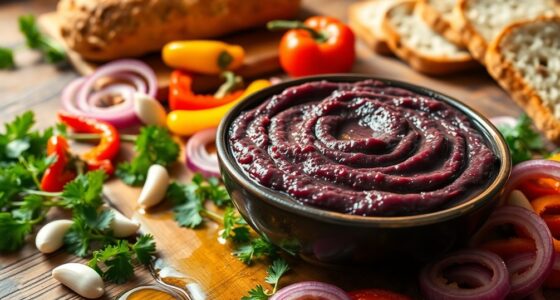Homemade pickled mackerel is a flavorful treat you can easily whip up in your kitchen. You'll start by cleaning and filleting the fish, then creating a brine with vinegar, water, sugar, and salt. After cooling the brine, pour it over the mackerel and refrigerate for a few days to intensify the taste. This method not only preserves the fish but also enhances its rich flavors. There's more to discover, so keep going to learn the details!
History

When you explore the history of pickled mackerel, you'll find its roots deeply embedded in Scandinavian cuisine, where this preservation technique emerged to extend fish shelf life long before refrigeration.
Ancient cultures, including those in the Roman Empire, employed similar methods, making pickling a time-honored practice.
Mackerel's oily flesh makes it especially suited for pickling, allowing it to absorb flavors and retain moisture.
This technique became crucial for sailors and fishermen, offering a nutritious food source that could withstand long sea voyages.
Today, homemade pickled mackerel is cherished for its superior flavor, often preferred over store-bought varieties.
It's celebrated in various dishes and serves as a traditional appetizer, reflecting its enduring legacy in culinary traditions.
Recipe

To get started, you'll need fresh mackerel, which should be cleaned and filleted. Ensure to remove the head, tail, and bones, and then pat the fillets dry to prepare for the pickling process.
Begin with fresh mackerel, cleaned and filleted, removing the head, tail, and bones for the perfect pickling preparation.
The brine itself is easy to make, requiring a balance of vinegar, water, sugar, and salt, heated until the sugar and salt dissolve. Once cooled, this mixture will transform the mackerel into a flavorful treat after a few hours in the refrigerator.
Ingredients:
- 2 whole mackerel
- 1 cup vinegar (white or apple cider)
- 1 cup water
- 1/4 cup sugar
- 1/4 cup salt
- Optional: bay leaves, peppercorns, garlic cloves
Instructions:
Begin by cleaning and filleting the mackerel, removing the head, tail, and bones, and then patting the fillets dry with paper towels.
In a saucepan, combine the vinegar, water, sugar, and salt, heating the mixture over medium heat until the sugar and salt are fully dissolved. Allow the brine to cool completely before placing the mackerel fillets in a suitable container and pouring the cooled brine over them, ensuring they're fully submerged.
Seal the container and refrigerate for at least 1 hour for quick pickling, or up to 3 days for a richer flavor.
Extra Tips:
For a more complex flavor, consider adding spices such as bay leaves, whole peppercorns, or crushed garlic to your pickling brine.
These ingredients can elevate the taste of your pickled mackerel and make it even more delicious. Additionally, keep in mind that while the pickled mackerel can be stored in the refrigerator for up to 2 days after pickling, it's best enjoyed fresh for maximum flavor.
Experiment with different vinegar types or sweeteners to create a unique brine that suits your palate.
Cooking Steps
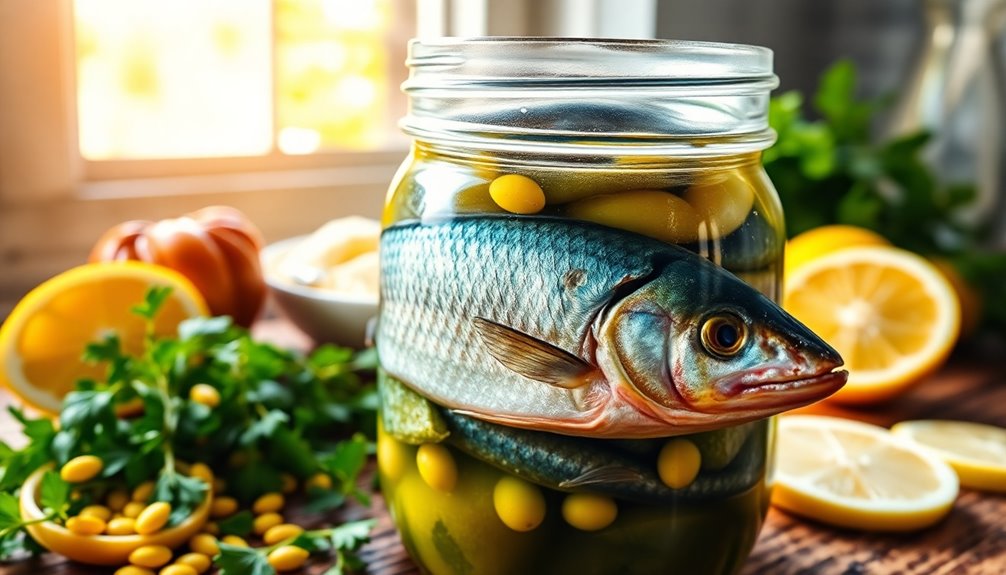
To start making your pickled mackerel, you'll first prepare the fillets by cleaning and seasoning them.
Next, you'll create a flavorful brine by adding spices and chilling it before submerging the mackerel.
Finally, refrigerate the mixture for 24 hours to let those delicious flavors meld together.
Step 1. Prepare Mackerel Fillets First
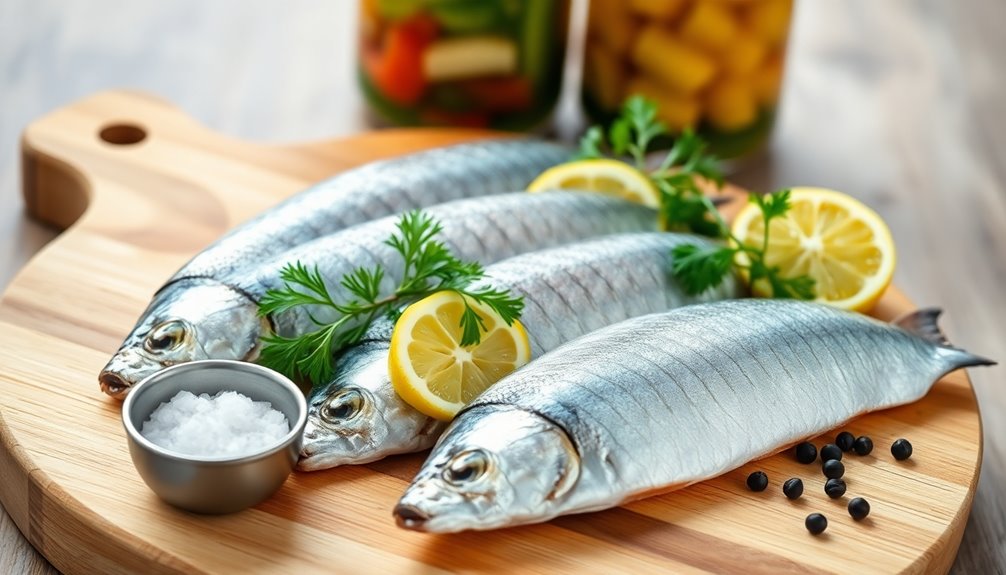
Start by thawing your frozen mackerel, then carefully remove the head and tail.
Next, clean the inside and remove any large bones. Rinse the fish thoroughly to eliminate any residual blood, then pat it dry with paper towels.
Generously sprinkle salt over both sides of the fillets, massaging it into the flesh to enhance flavor and help with preservation.
If you like, you can also season the fish with ground black pepper, crushed bay leaves, and coriander seeds for added depth.
Once seasoned, wrap the fillets in plastic wrap and refrigerate them for 2 days. This allows the flavors to develop and the brine to form, ensuring your pickled mackerel is delicious and ready for the next steps.
Step 2. Add Spices to Brine
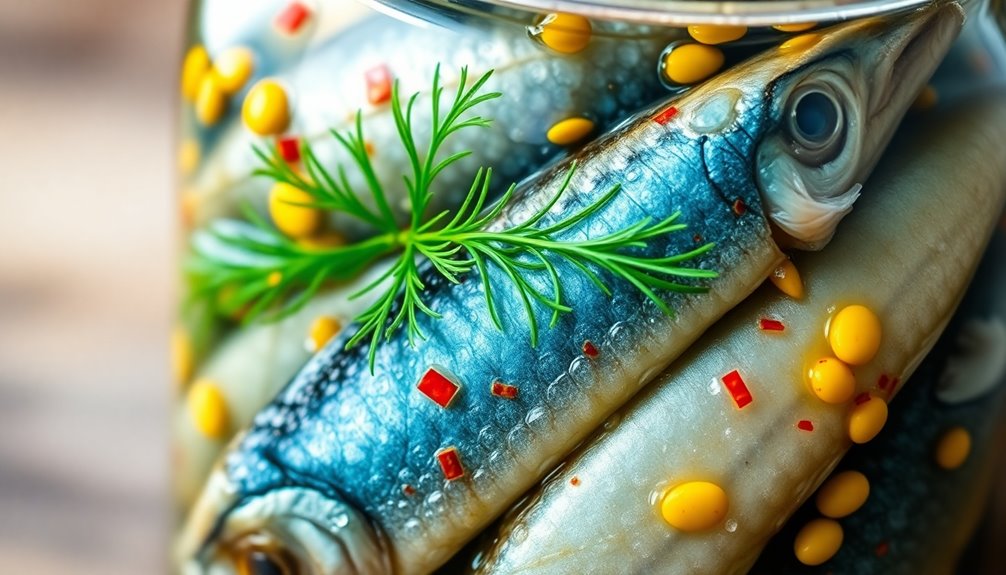
Adding spices to the brine is a crucial step that elevates the flavor of your pickled mackerel.
Start by preparing your pickling liquid with 70ml of white wine vinegar, 30g of sugar, and 5g of salt. Simmer this mixture over medium heat until everything dissolves.
Next, incorporate aromatic spices like crushed bay leaves, peppercorns, and coriander seeds for depth. If you want some heat, add dried chili flakes or fresh sliced chili peppers while marinating the fish.
Remember to use whole spices and crush them just before adding them to the brine; this freshness significantly enhances the flavor profile.
Allow the mixture to cool to room temperature before pouring it over your mackerel fillets.
Step 3. Chill the Brine Mixture
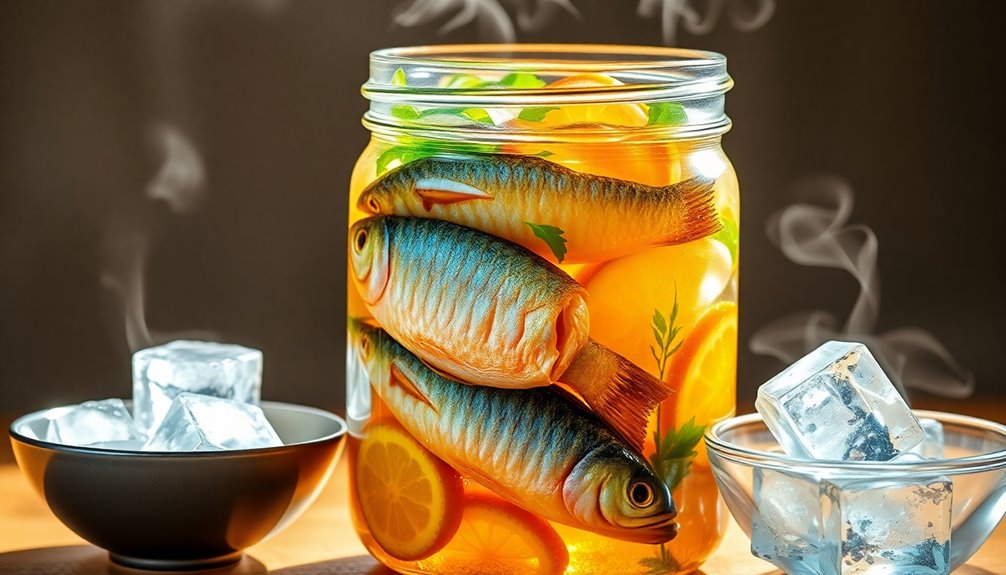
Chilling the brine mixture is essential for perfecting your pickled mackerel.
After you've combined vinegar, water, sugar, and salt in a saucepan, bring it to a boil to dissolve everything completely.
Once boiled, remove it from heat and let the pickling liquid cool to room temperature.
This step is crucial as it helps develop the flavors and prevents cooking the fish during marination.
If the brine's too hot, it can negatively affect the texture and taste of your mackerel.
Once cooled, pour the brine over the fish fillets, ensuring they're fully submerged for even pickling.
Refrigerate the fish in the brine for at least one hour; longer marination enhances the flavor even more.
Enjoy the process!
Step 4. Submerge Mackerel in Brine

Once your brine mixture has cooled, it's time to prepare the mackerel for pickling.
Start by coating the cleaned mackerel liberally with salt, allowing it to sit for about 1 to 1.5 hours to draw out moisture.
After rinsing, place the fillets in a dish and pour the cooled pickling liquid, which includes vinegar, over them.
Make sure to submerge mackerel in brine completely for maximum flavor.
For best results, refrigerate the fish for at least 1 hour, but don't hesitate to marinate for up to 3 days for enhanced taste.
Finally, before serving or storing your pickled fish, pat it dry to ensure the texture and shelf life remain intact.
Enjoy your homemade pickled mackerel!
Step 5. Refrigerate for 24 Hours
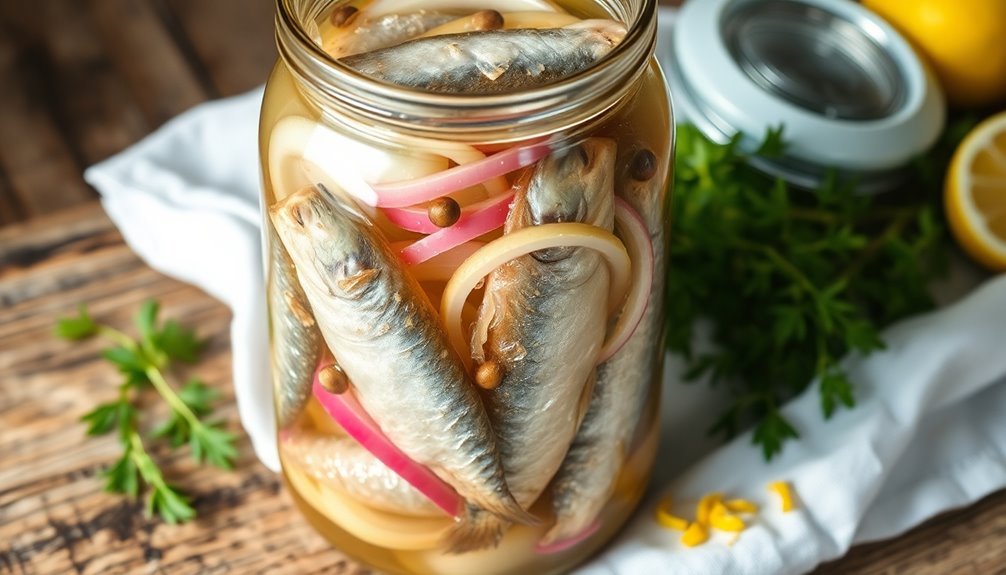
Refrigerate the mackerel for 24 hours to allow the brine to develop its flavors and fully penetrate the fish.
After preparing the mackerel with salt and seasonings, wrap tightly in plastic wrap or a bag to prevent any air exposure. This step is crucial for maintaining the quality of your pickled mackerel.
Place the wrapped mackerel in a deep bowl or pan to catch any liquid that may escape, keeping your refrigerator clean.
After 24 hours, check the mackerel to see if it's absorbed enough flavor; if you prefer a stronger taste, you can leave it for another day.
Once done, pat dry the mackerel before serving or freezing to maintain its delightful texture and flavor.
Final Thoughts
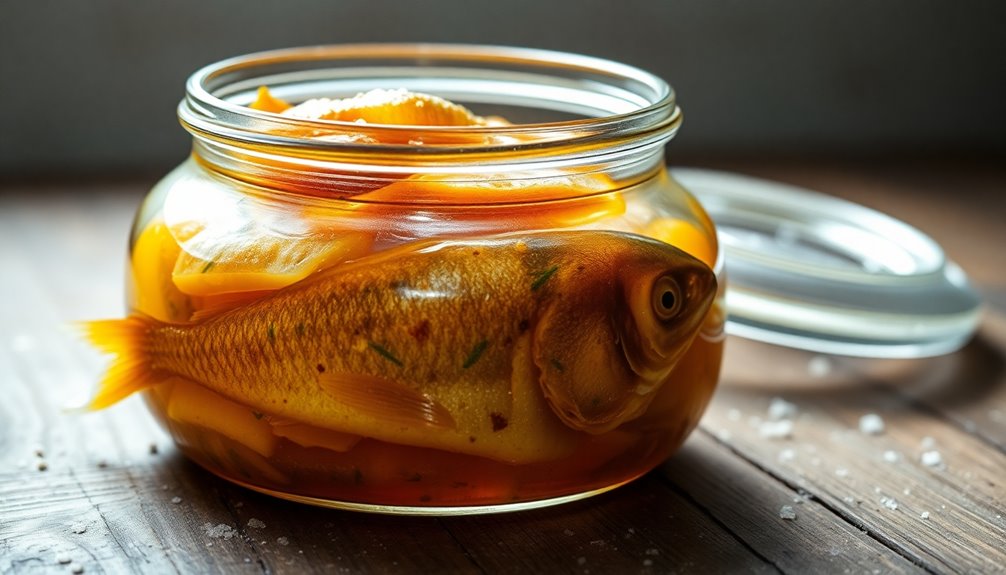
While experimenting with homemade pickled mackerel can seem daunting at first, you'll quickly discover it's a rewarding culinary adventure.
By using a simple brine of vinegar, water, sugar, and salt, you can create your own pickled mackerel tailored to your taste.
Remember, the marination time is key—whole fish need 4-5 days, while cut pieces only require an overnight soak.
Once ready, you can store your pickled mackerel in the refrigerator for up to a month, making it a convenient option for various fish dishes.
Plus, using deep-frozen salted fish ensures safety from parasites.
Frequently Asked Questions
Is Pickled Mackerel Good for You?
Yes, pickled mackerel can be good for you! It's high in omega-3 fatty acids, which support heart health and reduce inflammation.
You get a solid protein boost, aiding muscle repair and overall bodily functions. Plus, it's rich in vitamins D and B12, essential for bone health and energy.
Just remember, moderation's key, especially if you're watching your sodium intake. Enjoy it as part of a balanced diet for the best benefits!
How to Preserve Mackerel in Jars?
Imagine capturing the ocean's essence in a jar.
To preserve mackerel, start by filleting the fish, removing all bones and skin.
Create a brine with vinegar, water, sugar, and salt—tweak it to suit your palate.
Pack the fillets in sterilized jars with your favorite spices.
Cover them with cooled brine, ensuring the fish is submerged.
Seal the jars tightly, refrigerate, and let the flavors mingle for a couple of days before savoring.
What Is the Difference Between Pickled Mackerel and Herring?
When you compare pickled mackerel and herring, you'll notice distinct differences.
Mackerel's richer, more intense flavor comes from its higher fat content, while herring offers a milder taste that varies based on the pickling method.
The brine for mackerel usually includes vinegar, sugar, and spices, whereas herring can incorporate ingredients like mustard or dill.
Nutritionally, mackerel packs more omega-3 fatty acids, making it a healthier choice for those seeking beneficial fats.
What Is the Best Cooking Method for Mackerel?
When you think of mackerel, picture a golden sunset over waves, where the fish dances in the sea.
To capture that essence, grilling or broiling is your best bet. The high heat brings out its natural oils, creating a crispy skin that mimics that sunset glow.
Baking is also great, letting flavors meld beautifully. If you're after a crispy texture, pan-frying works wonders, while steaming keeps it light and nutritious.
Enjoy your culinary journey!
